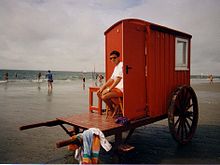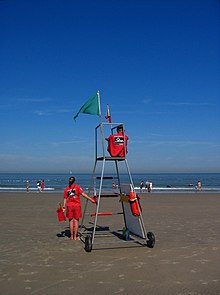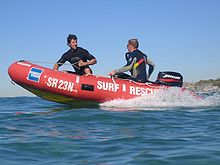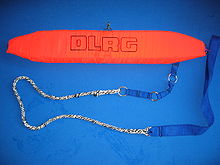Lifeguard


A lifeguard supervises the safety and rescue of swimmers, surfers, and other water sports participants such as in a swimming pool, water park, or beach. Lifeguards are trained in first aid and strong swimmers, certified in water rescue using a variety of aids and equipment depending on requirements of their particular venue. In some areas, lifeguards are part of the emergency services system to incidents and in some communities, the lifeguard service also carries out mountain rescues, or may function as the primary EMS provider.[citation needed]
Responsibilities
A lifeguard is responsible for the safety of people in an area of water, and usually a defined area immediately surrounding or adjacent to it, such as a beach next to an ocean or lake. The priority is to ensure no harm comes to users of the area for which they are responsible. Lifeguards often take on this responsibility as an employment, although they can also be volunteers.
The conditions resulting in drowning are summarized by the 'drowning chain' in which each link can lead directly to an incident, or contribute to a succession of links.[1] It consists of lack of education about water safety or local conditions, a lack of safety advice (for example, about rip currents at a beach) a lack of protection (like no flotation device for a weak swimmer), lack of safety supervision, or an inability to cope with conditions (strong surf with a weak swimmer).

The drowning chain provides a clear basis for preventing drowning which includes:[1]
- education and information
- provision of warnings
- denial of access
- supervision
- training in survival skills
The lifeguard is able to provide all these elements to help prevent drownings (or other incidents) in their area of responsibility, and for this reason this should be the primary focus of a lifeguard's activities, as it is better to stop an incident occurring than trying to react once it has occurred.[1] This means that the effectiveness of a lifeguard unit can be measured not the number or rapidity of rescues, or the skill with which they are executed, but the absence or reduction of drownings, accidents, and other medical emergencies.
Of course, lifeguards must be trained, capable and ready to perform emergency rescues should they become necessary, which they may do, as it is impossible to prevent all accidents occurring without going to unacceptable expense. This rescuing is the key focus of popular culture reference such as Baywatch, which was at one time the most viewed show in the world.[2]
Duties

A lifeguard's key duties on a beach (usually as part of a team, but in some places, lifeguards may occasionally be required to work on their own) are to:[3]
- Enforce rules in order to anticipate problems/injuries
- Maintain concentrated observation of the duty area and its users in order to anticipate problems (this will enable the lifeguard to intervene with one of the drowning prevention measures) and to identify an emergency quickly.
- Supervise the use of other equipment when allocated to that duty (such as water slides or any other activities taking place)
- Carry out rescues and initiate other emergency action as necessary
- Give immediate first aid in the event of injury to a bather or other incident
- Communicate with bathers and other users to help fulfill the above tasks
Lifeguards may have other secondary duties such as cleaning, filing paperwork, checking a swimming pool's chlorine and pH levels or acting as a general information point. It is important that lifeguards never allow their secondary responsibilities to interfere with their primary responsibilities.[4]
Identifying types of swimmer
While performing patron surveillance (usually from an elevated stand or a water-level standing or sitting position) lifeguards watch for and recognize struggling or drowning swimmers, and swimmers with sudden medical conditions such as a stroke, heart attack, asthma, diabetes, or seizures. Lifeguards look for swimmers in various categories and conditions:
- Passive drowning victims are inactive in the water, submerged or otherwise. When a lifeguard sees this kind of swimmer he performs an emergency rescue.
- Active drowning victims are taking in water while attempting to stay at the surface. Lifeguards look for swimmers in this condition by looking for arms moving or flapping laterally (in an effort to press down on the water and leverage the head above the water's surface), not necessarily flailing, with the body vertical and no supporting kick. This behavior is known as the instinctive drowning response.[5][6] Lifeguards perform an emergency rescue to assist this kind of swimmer as their behavior results from being incapable of more active efforts to survive. They may be less than 20 - 60 seconds from sinking underwater.[7]
- Distressed swimmers are having trouble swimming, perhaps from fatigue, and may or may not be calling out for help. Lifeguards usually swim out and help these swimmers to the side. They may or may not require additional assistance.
- Normal swimmers (Healthy swimmers) are those who do not need any support and can swim on their own doing intermediate strokes (swimming standards).
Locations

Lifeguards can be found patrolling many different types of water, and each type has its own unique features, duties and challenges. Locations where lifeguards can be found include:
- Ocean beach - Lifeguards are commonly associated with beaches on the seashore, and this is often considered the most challenging environment to lifeguard due to the influence of external factors such as weather, currents, tides and waves
- Inland body of water - Lifeguards can also look after open water areas such as lakes, or even rivers, where swimmers may congregate
- Swimming pool - Pools, either indoor or outdoor, are often patrolled by lifeguards, although many are not covered by qualified personnel, if at all
- Water park - Whilst water parks are a type of swimming pool, they can be considered a unique type of facility as they may involve additional features such as water slides or wave generators
- Ocean lagoon or tidal pool - These enclosed areas use seawater, but like a pool have a limited and contained area, but have the potential for additional hazards above and beyond an artificial pool
- Open ocean - In some cases, people may swim in the open ocean from a boat (such as a cruise ship) and lifeguards may be employed for safety in this instance
Positioning

Lifeguards have a primary duty to supervise the area which they are responsible for, and to achieve this the lifeguard needs to obtain an optimum position for observing the public. This is often best achieved from an elevated position, which can be a chair, platform or even the roof of a vehicle. This allows them maximum visibility over their supervised area and may facilitate communication between them and their team.
Some lifeguard teams use portable platforms or chairs which can be moved to the most appropriate position. This can help take account of changes such as a specific activity taking place, prevailing wind direction or simply enable lifeguards to move closer to the water if the tide goes out on a beach.
The chair or tower can also act as storage for the lifeguard, holding their important rescue or communication equipment close to hand. It can also act as a recognizable point for members of the public to find lifeguard assistance. For this reason, it is often marked with a flag or flags to enable location by the public, and these flags may also give information to the bathers about the conditions for swimming.
Other options, depending on the location, can include patrolling the edge of the water on foot, which allows closer interaction with the public, and the opportunity to provide face to face reassurance and advice, or even supervising from within or on the water, which is most applicable in open water (such as the sea or even a large water park) where lifeguards can use boats or other personal watercraft to be within the water, which extends their range and may allow quicker response to emergencies.
Equipment





Equipment used by lifeguards will vary depending on the location and specific conditions encountered, however certain equipment is relatively universal such as a whistle for attracting the attention of the public or other members of the team, a first aid kit and rescue aids.
Rescue aids
There is a hierarchy of rescue techniques, in order, which minimizes danger to the lifeguard and maximizes the effectiveness of a rescue, and this dictates the types of rescue aids that a lifeguard should have available. Lifeguards are supposed to have some equipment to aid rescues. After determining a swimmer is in trouble they try to help in ways that will not result in a threat to the life of the lifeguard or others. This is done by helping at a distance by using a pole; a lifebuoy may be thrown, wading to the victim, using available watercraft, swim with an aid, such as a rescue buoy. As a last resort, direct swimming to the apparent victim.
In addition to these basic lifeguarding techniques, some units are trained in additional water rescue techniques such as scuba diving or in rescue techniques unrelated to water rescue such as abseiling for cliff rescue and will carry appropriate equipment for these.
First aid
Lifeguards are proficient in first aid, and have a well stocked first aid kit available. They may have advanced first aid items such as medical oxygen, a resuscitator, a defibrillator or AED or a spinal immobilisation board. Some are trained Emergency Medical Technicians.
Communications
Effective communications are vital for lifeguards and they may choose to use whistles, two-way radios, megaphones or even signal flares.
A more traditional method of communication with the public is through the use of colored flags, which can be raised over permanent or temporary flag poles to inform members of the public of different information.
Transportation
For duty areas over a wide area, such as beaches and lakes, lifeguards may require transport over distance and they may use land transport including pick-up trucks, quad bikes or other off-road vehicle.
They may also use larger water craft such as large rigid or inflatable boats or even hovercraft.
Lifeguards in different nations
Australia
In Australia lifeguards are distinguished from Surf Life Savers. Lifeguards are paid employees who patrol beaches, lakes and pools/aquatic venues. Beach lifeguards are usually employed by local government authorities and patrol the beach throughout the year. Surf Lifesavers are a large voluntary organization that patrol beaches on weekends and public holidays during the warmer months (usually from mid-September to late April) and also perform public training of kids, the nippers, as well as competitions, such as surf carnivals or winter swimming events.
Belgium

Belgium has a coastline with a length of 68 kilometres (42 mi). The coast is urbanised over practically its entire length and is visited by thousands of tourists each year. A lifeguard service has been built up. Because the North Sea only borders Flanders, more particularly the province of West Flanders, the training of the lifeguards is organised by that province. Beach lifeguards in Belgium are trained by the WOBRA [11][12] Beach lifeguards in Belgium are mostly students who are employed for a month during the summer holidays (July and August). Some municipalities also employ lifeguards in June and September. To obtain uniformity, all municipalities from the Belgian coast joined the IKWV[13][14] This is the coordinating organisation for all the municipalities for lifeguard service.
Canada
In Canada, all lifeguards and assistant lifeguards (Lifesaving Society does not have an Assistant Lifeguard Certification but trains lifesavers) are certified by the Lifesaving Society of Canada and the Canadian Red Cross. The lifeguarding certification offered by the LSS is the National Lifeguard Service (NLS) program, which was officially launched in 1964. There are four types of lifeguard certification: pool, surf, waterpark, and waterfront.
In November 2009, the Canadian Red Cross Lifeguard program was developed in accordance with the International Red Cross quality standards and meets all provincial/territorial legislation requirements in addition to being aligned with the international lifeguard standards.[citation needed]
Denmark

In Denmark the lifeguard-services are divided into two major groups. The coastal lifeguards, which are established on a voluntarily basis by the beach administrators (in most cases the municipality). There are three main serviceproviders for this, two heavily sponsored: Kystlivredderne.dk[15] and TrygFonden Kystlivredning,[16] while Den Nordsjællandske Kystlivredningstjeneste [17] are sponsored by the councils at the Zealand Northshore. All public pools (both commercial and government) are required to "provide a secure and safe environment" and thus lifeguards. Unlike the coastal lifeguards, these has to pass an government approved test as well as a yearly a physical examination and first aid test.
Germany

In Germany three major organizations exist that train people in swimming, lifesaving and which maintain lifeguard services at public beaches, lakes etc. All three are mainly based on volunteer work. The DLRG(Deutsche Lebens-Rettungs-Gesellschaft - German Life Saving Society) is the largest aquatic lifeguard organization in the world with more than 1,000,000 members and promoters.[18] The Wasserwacht (water watch) is a division of the German Red Cross. Third is the Wasserrettungsdienst of the Arbeiter-Samariter-Bund.
Ireland
In the Republic of Ireland, the statutory body established to promote water safety is "Irish Water Safety" who train and award Lifeguards with the National Pool Lifeguard Award, the National Beach Lifeguard Award and the Inland Open Water Lifeguard Award.[19]
Northern Ireland
In Northern Ireland, the Royal Life Saving Society (RLSS IRELAND) also provide training in lifesaving and courses in lifeguarding for both the National Pool Lifeguard Qualification (NPLQ) and the National Beach Lifeguard Qualification.[20]
Italy
In Italy Lifeguard are certified by the Italian Swimming Federation[21] the National Lifesaving Society[22] and the Italian Water Rescue Federation[23]. The Italian Swimming Federation's diploma is recognized abroad by the country affiliated to ILS whilst the National Lifesaving Society is active member and internationally recognized by the International Maritime Rescue Federation[24]. Differences exist between pool, lakes and sea diplomas. Also Italian Red Cross has a special branch called OPSA[25] (Polyvalent Water Rescue Operators) that has some lifeguards duties in some parts of Italy.
New Zealand
In New Zealand the term lifeguard generally refers to swimming pool lifeguards but can be used interchangeably with lifesaver. These are qualified paid professionals employed by the pool management to watch over pool users. Surf Life Saving New Zealand (SLSNZ) is responsible for training and maintaining coastal Surf Lifesaving in New Zealand. Surf Lifesavers patrol various beaches in New Zealand. Lifesavers are able to sit their Bronze Medallion which qualifies them as a volunteer Surf Lifeguards. Volunteers patrol New Zealand's beaches on weekends over the summer months from Labour Day to around Easter. Paid Lifeguards patrol beaches during the week over the busiest summer months. They also come under the control of SLSNZ.
Spain
In Spain there are many organizations that teach and train people in lifesaving. The International Lifeguard Society and Federación Española de Salvamento y Socorrismo are a couple of the prominent organizations.
Switzerland
In Switzerland the lifesaving organization is the Swiss Lifesaving Society.
Taiwan
In Taiwan there are two main lifesaving organizations providing lifeguard licenses and training, one is called National Water Life Saving Association Republic of China (NWLSAROC) another is called The Red Cross Society of the Republic of China. NWLSA was first launched in 1970 and aided by Australians Surf Life Savers. The Red Cross Society was founded around 1949. NWLSA joined the International Life Saving Federation in 1994.
United Kingdom
Pool lifeguards
In the United Kingdom, there are two bodies that train Lifeguards, the Swimming Teachers Association[26] and the Royal Life Saving Society UK (RLSS).[27] The organisations' qualifications are the National Aquatic Rescue Standard and the National Pool Lifeguard Qualification respectively. The pool Lifeguard qualification is administrated by the IQL[clarification needed][28] on behalf of the RLSS.
Both qualifications are recognised professionally within the United Kingdom and enable the holder to work as a Professional Pool Lifeguard satisfying all HSE[clarification needed] regulations. For Public Swimming sessions a full lifeguard qualification is recommended by the HSE in the Managing health and safety in swimming pools manual.[29]
A full Pool Lifeguard course lasts a minimum of 36 hours and ends with external examiners testing the individuals both on land and in the water and includes an examination paper. The qualification is valid for two years from the date of assessment. A minimum of 20 hours training must be logged in those two years for the individual to be eligible to submit for a renewal examination. The employer of the lifeguard should provide training every month in lifeguard skills and resuscitation training to help it comply with HSE guidelines. Additional units can be added including the use of spinal boards, a specialist piece of rescue equipment designed for immobilizing a casualty suspected of suffering a Spinal Cord injury.
The Professional element of the award is not attained until the testee is working within a swimming pool complex and has covered Site Specific training sessions. This is Unit 2 and is prescribed by the ISRM.[clarification needed][30]
All RLSS qualifications are trained by TAs (Trainer/Assessors) these are more often experienced lifeguards or lifesavers who have undergone additional training in order to train and assess. Many Leisure centres have their own TAs who operate in-house training for the Lifeguards. TAs also assess qualification renewals but are unable to assess any Lifeguard that works in the same place the TA hold training sessions. Also they are unable to assess any Lifeguard they have trained. These rules are to reduce the risk of collusion.
Beach lifeguards
The two alternative schemes for qualifying beach lifeguard in the UK are run by the Royal Life Saving Society UK, who offer the 'National Beach Lifeguard Qualification' (NBLQ) and Surf Life Saving Great Britain (in association with the Royal National Lifeboat Institution) who offer the 'National Rescue Standards Beach Lifeguard Qualification' (NaRS BL).
Both organisations also offer a range of "specialist modules" that can be added to the basic qualification, such as VHF Radio Operator; Rescue Water Craft RWC, Rescue Surf Skills, Rescue (paddle) Board, Rescue Boat (Crew), Rescue Boat (Driver), AED and CPR Oxygen Administration.
The RNLI is the largest operator of lifeguard units in the UK, patrolling over 140 operational beaches around the coast of England and Wales.[31]
Canoe lifeguards
The British Canoe Union[32] has canoe life guard units in the UK managed by the BCU Lifeguards.[33] These are special units that operate in Kayaks and Canoes in areas where motor boats would have problems.
Open water lifeguards
Inland water sites such as lakes and rivers - typically where there is a specific need, such as sports competitions or public events. There are many examples of organisations that provide such services on a national, international, voluntary and commercial basis.
United States

In the United States there are several nationally recognized organizations that certify lifeguards. The American Red Cross Lifeguarding program,[34] American Lifeguard Association,[35] the YMCA, the City of Los Angeles,[36] and the Boy Scouts of America. These organizations certify people in first aid and CPR for that do not get the lifeguard certification. The standard in open water surf training is the United States Lifesaving Association.[37]
In 2009, 117 drowned at the nations beaches; 21 where lifeguards were on duty. There were 82,969 rescues reported from 114 reporting agencies.[38]
Lifeguard competitions
Continuous training is necessary to maintain lifeguarding skills and knowledge. Formal competitions have developed as a way to encourage training, and also as a social activity. In Australia, the annual Surf Lifesaving competition at Kurrawa Beach on the Gold Coast is the largest athletic event in the world after the Olympic Games with tens of thousands of lifeguards competing. Lifeguard competitions include both physical events and technical (medical) events. Technical events are challenging accident simulations in which guards are evaluated on their adherence to treatment standards. These events are a subject of controversy amongst some lifeguards due to their subjectivity. Purely physical competitions have recently become more popular, often including various combinations of running, swimming, paddleboarding, and surf skiing. Most lifeguard competitions include an Ironman event that combines three different physical activities.
- Australian Surf Life Saving Championships, Perth Australia
- Risser's Beach, Nova Scotia
- Bournemouth Lifeguards Corps Regatta, UK
- Nova Scotia Surf League
- British Universities Lifesaving Clubs Association League
- Federacion Aragonesa de Salvamento y Socorrismo
See also
References
- ^ a b c Whatling, Shaun. Beach Lifeguarding. Royal Life Saving Society. ISBN 0-907082-41-6.
- ^ "Largest Audience For A TV Series". Guinness World Records.
- ^ Beach Lifeguard Manual. The Surf Life Saving Association of Great Britain (SLSA GB)/The Swimming Teachers Association (STA)/The Institute of Leisure and Amenity Management (ILAM). 1998.
- ^ American Red Cross Lifeguarding Participant's Manual pg. 3
- ^
Pia, Frank (1971). "On Drowning" (Document). Larchmont, NY: Water Safety Films, Inc.
{{cite document}}: Unknown parameter|edition=ignored (help) - ^ Pia, Frank (1974). "Observations on the drowning of nonswimmers". Journal of Physical Education. Warsaw, IN: The YMCA Society of North America.
- ^ Vittone, Aviation Survival Technician First Class Mario (Fall 2006). ""It Doesn't Look Like They're Drowning": How To Recognize the Instinctive Drowning Response" (PDF). On Scene (journal of US Coastguard search and rescue). p. 14. Retrieved 2010-12-29.
{{cite web}}: Unknown parameter|coauthors=ignored (|author=suggested) (help)CS1 maint: year (link) - ^ http://www.usla.org/about/history.asp
- ^ http://www.ilsf.org/webfm_send/65
- ^ http://books.google.com/books?id=VWnxpAxp6TMC&pg=PA590&lpg=PA590&dq=pete+peterson+tube&source=web&ots=9CsQGO7-jm&sig=e9A1xAWJYLesnXFJKZA9pkhQ1VI&hl=en&ei=nJSQSbisO5DDjAfuvdSbCg&sa=X&oi=book_result&resnum=8&ct=result
- ^ WOBRA
- ^ Dutch abbreviation for West Flemish training centre for firemen, lifeguards and ambulance crew
- ^ IKWV
- ^ Dutch abbreviation for intercommunal coast lifeguard service of West Flanders
- ^ "Kystlivredderne.dk" (in Danish). Retrieved 2008-12-02.
- ^ "TrygFonden: Bliv livredder" (in Danish). Retrieved 2008-12-02.
- ^ "Den Nordsjællandske Kystlivredningstjeneste" (in Danish). Retrieved 2009-03-01.
- ^ [1]
- ^ Details of Irish Water Safety classes
- ^ Details of all lifeguard courses and activities
- ^ FIN Salvamento
- ^ Società Nazionale di Salvamento
- ^ Federazione Italiana Salvamento Acquatico
- ^ International Maritime Rescue Federation
- ^ Operatori Polivalenti di Salvataggio in Acqua
- ^ Swimming Teachers Association
- ^ Royal Life Saving Society UK
- ^ IQL
- ^ ISBN 978-0-7176-2626-1
- ^ ISRM
- ^ "RNLI Lifeguards". Royal National Lifeboat Institution.
- ^ British Canoe Union
- ^ BCU Lifeguards
- ^ Lifeguarding program
- ^ American Lifeguard Association
- ^ [2]
- ^ United States Lifesaving Association
- ^ Sharp, David (12 August 2010). "Rip tides making life tough for lifeguards". Portland, Maine: Portland Press Herald. pp. B2.
External links
- International Life Saving Federation
- International Life Saving Federation of Europe
- Training video and example of drowning response - youtube (Audio missing during 0:17 - 0:58 of the video)

